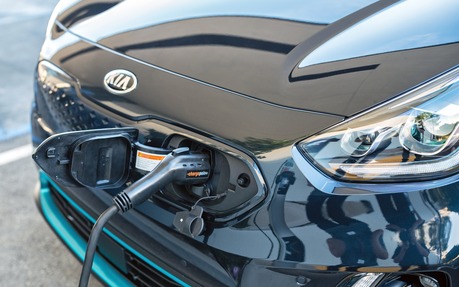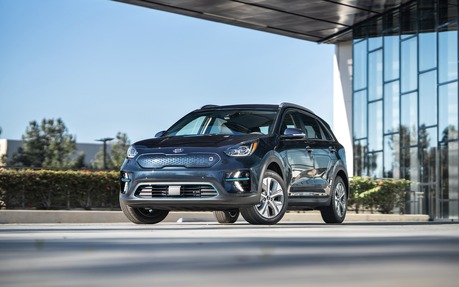2019 Kia Niro EV: An Electric Car Worthy of More Attention
Since the launch of the Nissan LEAF in 2011, affordable electric vehicles offering zero range anxiety have become more and more popular.
One of them is the Kia Niro EV, the third member of the Niro lineup following the hybrid and plug-in hybrid variants.
- Also: 2019 Kia Niro EV and 2020 Kia Soul EV: Pricing Announced
- Also: 2019 Kia Niro EV: Chock-full of Electrons
Originally launched for the 2017 model year, the Niro is not a household name in Canada. It currently ranks seventh among all Kia vehicles in terms of sales, well behind SUVs like the Sorento and Sportage, plus the Forte compact car. Conservative styling may be to blame, especially when compared with the similarly sized Soul hatchback.
As mentioned above, the Korean-built Niro has a standard hybrid variant that rivals the widely recognized Toyota Prius and a plug-in hybrid model aimed at the Prius Prime, Chevrolet Volt and Honda Clarity. After a so-so start, sales of the Niro PHEV are now on the upswing.
Meanwhile, the recently introduced Niro EV is Kia’s response to the Chevrolet Bolt EV, Nissan LEAF Plus and Hyundai Kona Electric—not to mention the brand’s second fully electric model after the Soul EV, which debuted back in 2015.

No Range Anxiety
The Kia Niro is a five-passenger compact crossover that shares its platform with the Hyundai IONIQ, another vehicle offering three different forms of electrification. Equipped with a larger battery than the IONIQ Electric, the Niro EV provides more range (385 km vs. 200 km) and is priced similarly to its direct competitors—a good combination to attract customers.
There’s much more to it, of course. Build quality is excellent and interior fit and finish is impeccable. The cabin will comfortably accommodate four normal-sized adults, maybe even five, and the versatile trunk is surprisingly spacious given the size of the body. Maximum cargo capacity actually exceeds that of the bigger Sportage. You won’t have to fold the rear seats to carry a big stroller, which might not be the case with the Soul EV.
Overall, this electric crossover is a perfect travel companion both in terms of range and utility, although the ride is fairly stiff and definitely not as smooth as the LEAF’s.
The Niro EV features a regenerative braking system allowing one-pedal driving in most situations. When you release the throttle, the system acts as an engine brake and lost kinetic energy is converted into electricity to charge the battery, at which point the available range indicated on the instrument cluster goes up instead of down.
Regenerative braking can be adjusted by the driver, but I must warn you that the most aggressive setting makes for a jerky and unpleasant drive. The LEAF’s system, once again, is much smoother and more transparent in comparison.

The Fastest
Here’s a fun fact: the Kia Niro EV is faster than the standard Niro and the Niro PHEV. The 150-kilowatt electric motor sends 291 pound-feet of torque to the front wheels as soon as you depress the pedal, so it only takes 7.8 seconds to reach 100 km/h. The other Niros will do it in about nine and ten seconds, respectively.
Said motor is fed by a 64-kWh battery mounted under the floor. It’s the same unit found in the Soul EV Limited (not to mention the Hyundai Kona Electric), which retails for $51,595—a much higher price than the Niro EV EX at $44,995.
Our tester was a generously equipped Niro EV SX ($53,995) that adds, among other things, LED headlights, a power sunroof, leather seats and a number of driver assistance systems. Both the steering wheel and front seats are heated, while the heat pump is less power-hungry. Considering our rough winters, it would have been nice to have those features in the base Niro EV, as well.

Get Your Charging Station Ready
According to Kia, a full charge of the battery takes nine hours and 35 minutes using a level-2 (240V) charging station and a whopping 59 hours via a regular power outlet (110V). Needless to say the purchase of a charging station is a must. Incentives may apply depending on where you live.
Speaking of which, buyers of a 2019 Kia Niro EV get a rebate of $5,000 from the federal government, plus $8,000 in Quebec or $3,000 in British Columbia. Can you see how good this deal is? It might just be the ultimate selling point you needed to make the switch to electric mobility.
| Test drive report | |
| Test model | 2019 Kia Niro |
|---|---|
| Trim level | EV |
| Price range | $25,495 – $42,000 |
| Price as tested | 42 000 $ |
| Warranty (basic) | 5 years/100,000 km |
| Warranty (powertrain) | 5 years/100,000 km |
| Fuel economy (city/highway/observed) | N/A |
| Options | N/A |
| Competitive models | Buick Encore, Chevrolet Bolt EV, Chevrolet Trax, Fiat 500X, Ford EcoSport, Honda HR-V, Hyundai IONIQ, Hyundai Kona, Jeep Renegade, Mazda CX-3, MINI Countryman, Mitsubishi RVR, Nissan Qashqai, Subaru Crosstrek |
| Strong points |
|
| Weak points |
|
| Editor's rating | |
| Fuel economy | |
| Comfort | |
| Performance | |
| Infotainment | |
| Driving | |
| Overall | |
